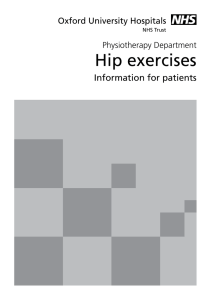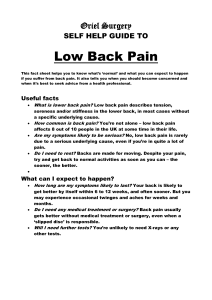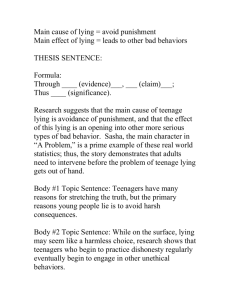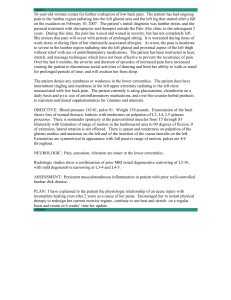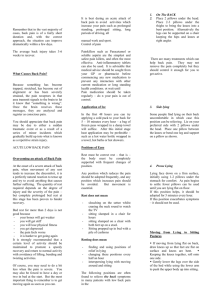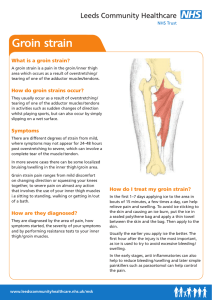Whiplash - Goring & Woodcote Medical Practice
advertisement
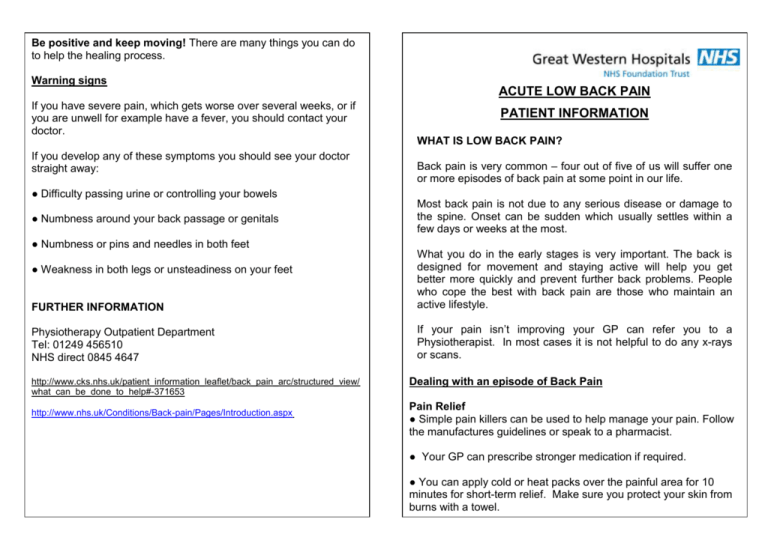
Be positive and keep moving! There are many things you can do to help the healing process. Warning signs If you have severe pain, which gets worse over several weeks, or if you are unwell for example have a fever, you should contact your doctor. If you develop any of these symptoms you should see your doctor straight away: ● Difficulty passing urine or controlling your bowels ● Numbness around your back passage or genitals ● Numbness or pins and needles in both feet ACUTE LOW BACK PAIN PATIENT INFORMATION WHAT IS LOW BACK PAIN? Back pain is very common – four out of five of us will suffer one or more episodes of back pain at some point in our life. Most back pain is not due to any serious disease or damage to the spine. Onset can be sudden which usually settles within a few days or weeks at the most. FURTHER INFORMATION What you do in the early stages is very important. The back is designed for movement and staying active will help you get better more quickly and prevent further back problems. People who cope the best with back pain are those who maintain an active lifestyle. Physiotherapy Outpatient Department Tel: 01249 456510 NHS direct 0845 4647 If your pain isn’t improving your GP can refer you to a Physiotherapist. In most cases it is not helpful to do any x-rays or scans. ● Weakness in both legs or unsteadiness on your feet http://www.cks.nhs.uk/patient_information_leaflet/back_pain_arc/structured_view/ what_can_be_done_to_help#-371653 http://www.nhs.uk/Conditions/Back-pain/Pages/Introduction.aspx Dealing with an episode of Back Pain Pain Relief ● Simple pain killers can be used to help manage your pain. Follow the manufactures guidelines or speak to a pharmacist. ● Your GP can prescribe stronger medication if required. ● You can apply cold or heat packs over the painful area for 10 minutes for short-term relief. Make sure you protect your skin from burns with a towel. Keep Active Exercises Keeping active and maintaining your normal everyday activities will help you recover more quickly from back pain. It is essential to start active exercise within 4 days of injuring the back. This will help to increase the mobility in the back and therefore reduce the pain. Try to stay at work or return as soon as possible even if your back pain is still present. The longer you stay off work, the more you are at risk of developing long-term problems and it can become harder to return to work. If you feel your work is difficult or unsafe to do because of your pain, speak to your manager as you may be able to alter your role temporarily. Try the following exercises at regular intervals through the day. They should be done slowly, moving into discomfort but not into excessive pain. 1) Lumbar rotation Do not stay in static positions e.g. sitting or standing. Change position at least every 30 minutes. Stay mobile to avoid becoming stiff. Lying on your back, gently roll your knees side to side in a slow controlled way and as far as you feel comfortable to go. Repeat 10 times to each side Walking and swimming are good forms of regular exercise. 2) Lumbar extension Postural Issues In standing or lying on your front, gently arch your back backwards as far as you feel comfortable to go. Repeat 10 times Good posture is important as this will aid the healing process and avoid aggravating the back pain. Regularly sit up straight. ● Sitting: Avoid low chairs that allow your bottom to sink below your knees. Avoid slouching. ● Sleeping: Most people benefit from having a medium to firm mattress. The mattress should be comfortable but firm enough to support the spine when lying on your back or side. ● Lifting/Bending: Avoid bending forwards; use your hips and knees to bend rather than your back. Avoid lifting and twisting where possible. ● Driving: Have your car seat fairly upright and raise your chair height iff possible. A small rolled towel placed in the back may help support a better posture. 3) Side flexion stretch Slide your hand sideways along your outer thigh as far as you feel comfortable to go. Do not lean forwards. Repeat 10 times to each side. If you find the exercises are making the pain worse stop doing them and speak to your GP or Physiotherapist.
